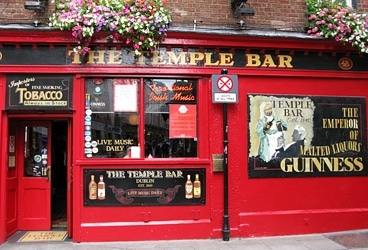Insider: Dublin, Ireland
By Bus or By Foot
Get your introduction to Dublin from the top – an open-top double-decker bus, that is. The Dublin Bus City Tour stops at all the main sights and allows you to get on or off at any stop. If you'd rather hoof it, there's the Dublin Historical Walking Tour, a two-hour jaunt through the past. For a highbrow excuse to hoist a few pints, try the "Literary Pub Crawl," which leaves from the Duke Pub on Duke Street. At each of the several taverns visited on the tour, professional actors perform scenes from Irish literature.
Rare Old Finds
From a petrified bog mummy to the first Gaelic-alphabet typewriter, the National Museum on Kildare Street is home to almost all of Ireland's most important archaeological finds. Artifacts from prehistoric Ireland, religious talismans from pagan times, coins and swords left by the Vikings, and one of Europe's best collections of Bronze Age gold — it's all here.
Retail Therapy
Stretching from Trinity College to St. Stephen's Green, Graf-ton Street is the main artery of the shopping district on Dublin's fashionable south side. The thoroughfare is lined with everything from the city's poshest department store, Brown Thomas, to some decidedly dodgy souvenir shops. You'll find contemporary fashions from such Irish designers as John Rocha and Deirdre Fitzgerald, and traditional tweeds and sweaters at Avoca Handweavers and the shops in the Powerscourt Townhouse.
Eating the Irish Way
When you see the line out the door, you'll know you've found Leo Burdocks. Tucked away on Werburgh Street, in the shadow of Christ Church Cathedral, this classic spot has been supplying the city with arguably the world's best fish-and-chips since 1913. Another Irish mainstay — the heaping plate of sausages, eggs, rashers (thick bacon), pudding, tomatoes, and toast known as the Irish breakfast — is just the thing to set you right after a night on the "batter" (beer). For the real deal done right, stop in at the upstairs Alpha Cafe, at the corner of Wicklow and Clarendon Streets.
Norse Neighborhood
The Vikings arrived in what is now Dublin back in 841 a.d., and at Wood Quay, along the banks of the Liffey, traces of them are still turning up in the mud. Most of the artifacts retrieved to date are housed in the National Museum, but at Dublin's Viking Adventure, the Norseman's world comes to life. A Viking long ship takes visitors to a re-created Viking settlement complete with ponds, fences, and pole-and-wattle houses. Costumed actors lead the tour and answer questions. It's a Viking saga – but without all that nasty pillaging.
Cultural Quarter
Until the late 1970s, the Temple Bar neighborhood was an inner-city slum. But cheap rents attracted artists, small merchants followed, and eventually the area evolved into Dublin's coolest. For a quick survey of contemporary Irish art, check out the Arthouse, the Temple Bar Gallery, or the newly remodeled Project Arts Centre. Film buffs can visit the Irish Film Centre. For celebrity-spotting, try the Octagon Bar in the U2-owned Clarence Hotel.
Religious Route
Christ Church Cathedral, built atop Dublin Hill around the year 1030, was for centuries the church of choice for Dublin's Anglo-Irish aristocrats. Many of those aristocrats are still there — buried in the crypt. Just a few blocks away, St. Patrick's Cathedral is less austere and contains some striking statuary. Memorials along the north wall honor British war dead through the ages. Don't miss the tomb of Jonathan Swift; the author of Gulliver's Travels wrote some of his sharpest satire while he was dean at St. Patrick's.
Trinity College
Ever since Queen Elizabeth I founded it in 1592, Trinity College has played a major role in Dublin life. Playwrights Samuel Beckett and Oliver Goldsmith attended, as did Jonathan Swift and Bram Stoker, author of Dracula. Its cobbled courtyard, rugby grounds, 18th-century architecture, and towering campanile make Trinity a scenic haven. The college's crowning glory is the Book of Kells, the seminal illustrated manuscript that dates back to 800 a.d.
Jigs and Reels
Though Galway is probably the hottest spot for traditional music, Dublin holds its own. O'Donoghue's Pub on Merrion Row is hard to beat; everyone from the Chieftains to the Dubliners has played here. The music starts in the evening, when musicians gather around the front tables. If you like what you hear, plan to visit Claddagh Records in Temple Bar. The independent record store has all you could hope for in traditional Irish music.
Pub Life
Dublin's pubs are renowned, some would say notorious, for their good times (craic in Irish) and their stout – the place for a quiet read or a wild night. Toners, The Stags Head, The Palace, Oliver St. John Gogarty's, and McDaids (a converted morgue) are all just a few minutes' walk apart. And don't miss Mulligans, on Poolbeg Street. Not five minutes from Trinity College, it is said to pour the best pint of Guinness anywhere.
